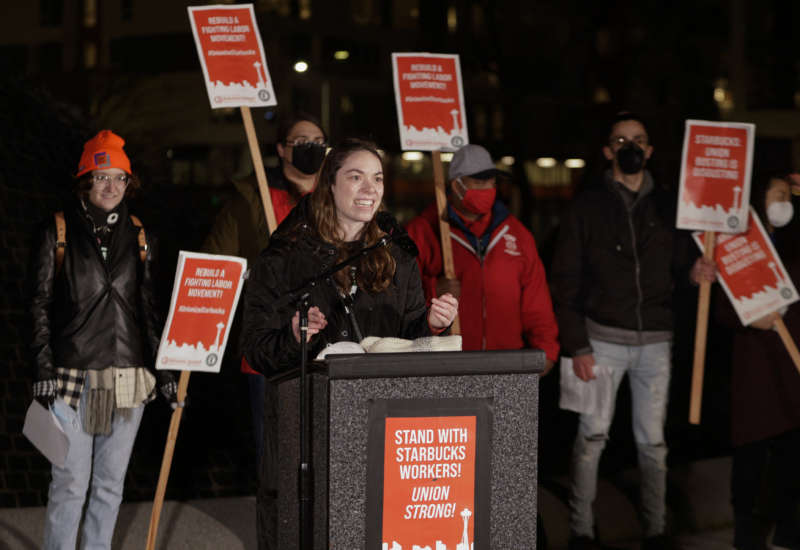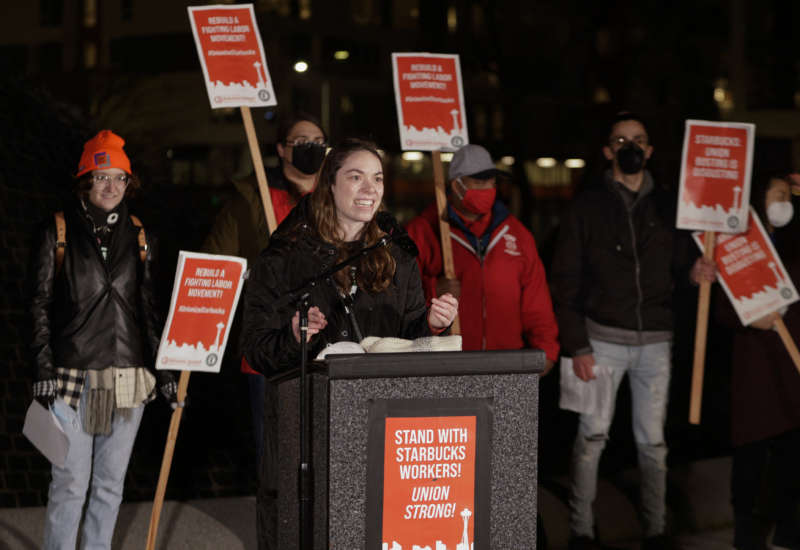The last two months have seen a veritable whirlwind of labor activism at Starbucks. Workers at more than 100 Starbucks stores in 26 states have now filed for union elections. In response, the company has bombarded workers with anti-union text messages; launched a slick anti-union website; forced workers to attend mandatory “captive audience” meetings; tried to pack bargaining units with newly hired employees who are trained separate from pro-union workers; threatened to close newly unionized stores in Buffalo, New York; and allegedly sacked pro-union workers at stores in Memphis, Tennessee, and elsewhere.
At least 30 attorneys from Starbucks’s law firm, anti-union giant Littler Mendelson, have sought to delay elections and contested workers’ right to vote in store-by-store bargaining units, arguing that Starbucks would fare better in large units composed of multiple stores and will benefit from election delay. These often-effective tactics have become a standard feature of corporate anti-union campaigns over the past 50 years.
So far, however, Starbucks’s multimillion-dollar anti-union effort has been remarkably unsuccessful and may even have backfired. The union, Starbucks Workers United, won two out of three elections at Buffalo in December; more recently, pro-union workers trounced Starbucks 25-3 in an election at a store in Mesa, Arizona, which is not exactly a union stronghold. The Biden administration’s National Labor Relations Board (NLRB) has rejected outright Littler Mendelson’s arguments for multi-store bargaining units — the NLRB has always viewed single stores as the appropriate unit in food retail — and on Monday, it rejected Littler’s arguments against single-store units for the third time, thereby allowing a count at another three Buffalo stores, and it’s likely that the Board will try to speed up the process to prevent similar delay at future stores that have petitioned for elections.
Thus, on Wednesday, Starbucks Workers United won all three elections at three more Buffalo area stores. The margins of victory were narrow, but prior to the count, the union had worried it might lose at least one, and possibly two, of the three elections. At the store, it expected would return a majority “no” vote, Starbucks had delayed the election, closed the store for two months, expanded the bargaining unit with new employees who were trained separately from pro-union workers, reduced hours and attempted to drive out pro-union workers through strict enforcement of its scheduling and other personnel policies — and yet it still lost. The small margins of victory at Buffalo (two by three votes, one by one vote) show that Starbucks’s campaign to delay elections and pack and purge bargaining units had an impact — one of the three stores had filed for an election with 85 percent of the original employees signing union authorization cards — but the aggressive, multimillion-dollar anti-union campaign is still losing vote counts and still failing to stop workers at more stores from filing for elections. Moreover, with 21 further NLRB elections scheduled to take place during the next six weeks, the latest three Buffalo victories could just signal the start of an important tipping point.
So, why has Starbucks’s union avoidance effort been such a dud?
Starbucks Captive Meetings Fail to Captivate Workers
A distinctive feature of Starbucks coffee stores is the comparative absence of direct managerial supervision. In contrast, at Amazon fulfillment centers, workers are monitored every second of every day. Once a Starbucks store is fully staffed with experienced baristas, it operates as a relatively autonomous unit with little managerial presence or oversight, thus providing baristas with ample opportunity to talk union with one another. And after they do this, Starbucks’s hackneyed anti-union propaganda becomes less effective and workers usually decide to choose the union. Workers have been bombarded with anti-union messages — often through mandatory captive audience meetings — but their minds are already made up, and the bullying nature of Starbucks’s anti-union campaign is likely even working against the coffee giant.
Starbucks’s young workers are not buying the arguments of its outside consultants about unions being “external third parties” who are only interested in their dues money, and know that they themselves are Starbucks Workers United. It must have come as a shock when, on discovering the Buffalo organizing drives, Starbucks flooded the stores with outside management, probably counterproductively, only to find their tried-and-tested intimidation tactics didn’t work as expected. In terms of the labor consciousness of young workers, we’re in a different moment than we were two years ago, but Starbucks and its consultants appear not to understand this.
Public approval for unions is at an almost 60-year high, with almost 80 percent of young people approving of unions.
Subsequent organizing has largely been a result of organic activism by workers who have been inspired by the examples of Buffalo and Mesa. If most Starbucks stores were to go union, it would be a powerful argument for the self-organization that authors of the 1935 National Labor Relations Act had originally contemplated. Littler Mendelson has advised clients to call police to eject professional union organizers, but it would be hard-pressed to find any outside organizers at Starbucks.
More Like Starbucks, Less Like Amazon
So how do we make the typical workplace in the United States more like Starbucks — at which employee self-organization could, at least in theory, flourish — and less like Amazon, at which any union talk is immediately crushed, and workers are routinely forced to attend anti-union meetings round the clock?
For starters, the Biden NLRB should separate the employers’ freedom to speak from their ability to make employees listen by prohibiting mandatory captive meetings, which could signal a variety of other non-legislative changes, with the goal of ultimately making employer speech no more coercive — and thus, no more commanding — than union speech. Pro-union workers face numerous legal obstacles, but getting rid of mandatory meetings is a starting point, and in light of the current Starbucks and Amazon union drives, it’s increasingly difficult to justify them with a straight face.
Absent Corporate Intimidation, Workers Will Choose Unions
There now exists a huge unmet demand for union representation in the U.S. workplace. A 2018 analysis by Massachusetts Institute of Technology professors shows that 50 percent of nonunion workers want union representation but can’t get it under the current system of employer-dominated elections. Public approval for unions is at an almost 60-year high, with almost 80 percent of young people approving of unions. Most young workers are not union members because they work at “young” nonunion workplaces and because the law gives free rein to powerful anti-union corporations like Amazon and Starbucks that spend millions to undermine worker organization. But they want just treatment on the job and increasingly view unionization as the way to achieve that goal.
Getting rid of mandatory captive meetings would be a good first step to challenging autocracy in the U.S. workplace. Prohibiting corporate interference in union elections might ultimately require the repeal of the ludicrously misnamed “free speech” provision of the 1947 Taft-Hartley Act, which is an anti-union measure that has been used as legal justification for many of employers’ most powerful and intimidating anti-union tactics, such as captive meetings. Our current conservative judiciary — which has weaponized corporate speech against workers — would make that tough going, but the country has never been more willing to consider it than right now.
Two Parting Shots From the Starbucks Campaign
One of the greatest obstacles to strengthening the right to choose a union has always been that few Americans understand how our labor law works. The union campaigns at Starbucks and Amazon, and the outstanding media coverage they have generated, have helped change that and have made clear two undeniable truths:
First, if Starbucks’s principal anti-union strategy is to impede voting and delay the counting of ballots, and to pack and purge designated bargaining units, top management needs to take a long, hard look at itself. Starbucks management wants its “partners,” and the public, to think of this campaign as the company vs. “Big Labor,” but, thus far, workers are not buying its propaganda about the union being an outside “third party” and believe that they themselves are Starbucks Workers United.
Second, the time has come to get rid of the obscene spectacle of multibillion-dollar corporations forcing $15-per-hour employees to listen to anti-union speeches conducted by highly paid professional “labor relations consultants.”
The union campaign at Starbucks provides a glimmer of the promise of worker self-organization; the question for the broader labor movement is, what can the broader labor movement do to best facilitate this process? Worker self-organization is also what corporate America fears most. Another prominent anti-union law firm wrote that the Starbucks campaign had “energized organized labor” and warned that “union-free companies should take note.” If the Biden NLRB resists Starbucks’s efforts to delay and undermine elections, taking note might not be enough to stop the spread of worker self-organization.



